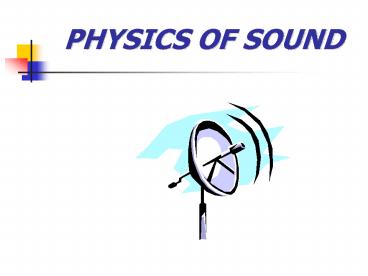PHYSICS OF SOUND PowerPoint PPT Presentation
1 / 18
Title: PHYSICS OF SOUND
1
PHYSICS OF SOUND
2
What is Sound?
- The sensation resulting from stimulation of the
auditory mechanism by air waves or other vibration
3
Requirements For Sound...
- Source of vibration (such as vocal folds)
- Source of energy (such as lungs)
- A medium (to carry the vibration, such as air)
- A receiver (such as the human ear)
Graphic from Jay Rose website at
http//www.dplay.com/book/sample.html
4
What is Noise?
- Any unwanted sound
- Varies from person to person!
5
Transmission of Sound
- Sound travels in waves, leaving point of origin
in a spherical pattern (in air) - series of compressions and rarefactions
- Usually depicted as a sine wave
- One complete vibration cycle, 360 degrees of
motion - Speed of Sound increases with density of the
medium - 1100 ft/second in air
- 4500 ft/sec in water
- 15,000 ft/sec in steel
6
The Sine Wave (Pure Tone)
- Horizontal Axis time in seconds
- Vertical Axis molecular movement
- Compression upward movement
- Rarefaction downward movement
- Amplitude height of wave intensity
7
FrequencyPitch/Hz
- Perceived as Pitch.
- Equal to the number of complete cycles that occur
in one second. - one cycle one compression and one rarefaction.
- Measured in Hertz (Hz).
8
Human Hearing
- Human range 20-20,000 Hz
- Human ear is most sensitive in the 1,000 - 4,000
Hz range. - Less sensitive in lower frequencies.
- HL Scale was developed normalized to represent
human hearing.
9
IntensityLoudness/dB
- Perceived as Loudness.
- Intensity is expressed as the sound pressure
level (SPL), which is a function of distance the
vibrating object is displaced (amplitude), which
depends on energy applied. - Measured in decibels (dB). One dB is 1/10th of a
bel. - Decibels are logarithmic units. The reference
used is .0002 dynes/cm2, roughly the smallest
pressure that will move the TM.
10
Intensity (cont.)
- Why logarithms?
- To compress the very large range of pressure our
ears can hear in to a small range of numbers for
convenience. - 0-140 dB represents a sound pressure range of
11,000,000,000 units (a ratio of 10 million to
1!)
11
Intensity (cont.)
- 0 dB is typically the softest volume that can be
heard, but sound energy is also present below 0
dB. - Human intensity range is 0-140.
- 140 dB is the threshold of pain.
- 170-180 dB causes tissue damage.
- 180 dB can cause death!
12
INVERSE SQUARE LAW
- Doubling the distance from a sound source
decreases intensity by 6 dB.
13
Doubling the Noise Source
- A combination of two different noise sources of
equal loudness will increase the intensity by 3dB - For example, if noise source A is 93 dBA and
noise source B is 93 dBA, the combined result
of A and B is 96 dBA.
14
DurationTime
- Perceived as Time.
- Can last from thousandths of a second, to several
hours or all day! - Occupational noise exposure varies over time.
- Can be constant or intermittent with continuous
(steady-state) or impulse noise.
15
SpectrumQuality
- Perceived as the Quality of sound.
- Varies from a simple pure tone to a complex mix
of many frequencies and intensities such as the
human voice. - Range is infinite.
16
Hazardous Noise Levels Defined As
- Continuous or steady state noise gt 84 dBA
- Generator, Aircraft Noise, etc.
- Impulse/Impact noise gt 140 dB peak SPL
- Explosions or weapons fire
- Two or more objects hitting together
- Intensity and duration are the two main factors
that determine if a particular sound is hazardous - If it is loud enough for long enough, most people
will suffer hearing loss. Often takes many
years!
17
Sensitivity of the Human Ear (Review)
- Frequency Range 20 - 20,000 Hz
- Intensity Range 0 - 140 dB SPL
- Referred to as the dynamic range
- Sounds gt140dB lose tonal quality
- Primary speech frequencies 500 - 4000 Hz
- Frequencies above and below add quality to
speech, but little intelligibility - Consonant Sounds Primarily high freqs, convey
80 of meaning of speech - Vowel Sounds Primarily low freqs, convey 80
of energy of sounds - Threshold The lowest intensity that the human
ear can hear
18
ANY QUESTIONS?

